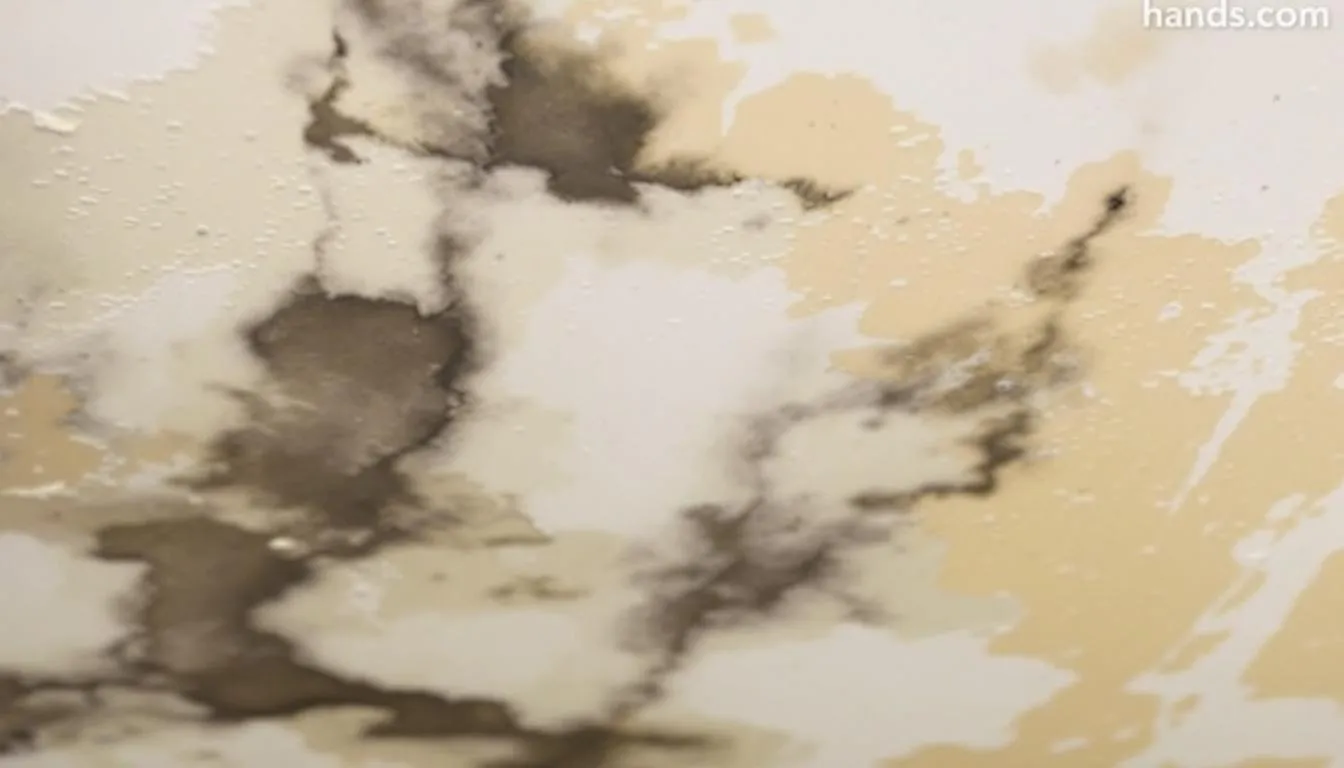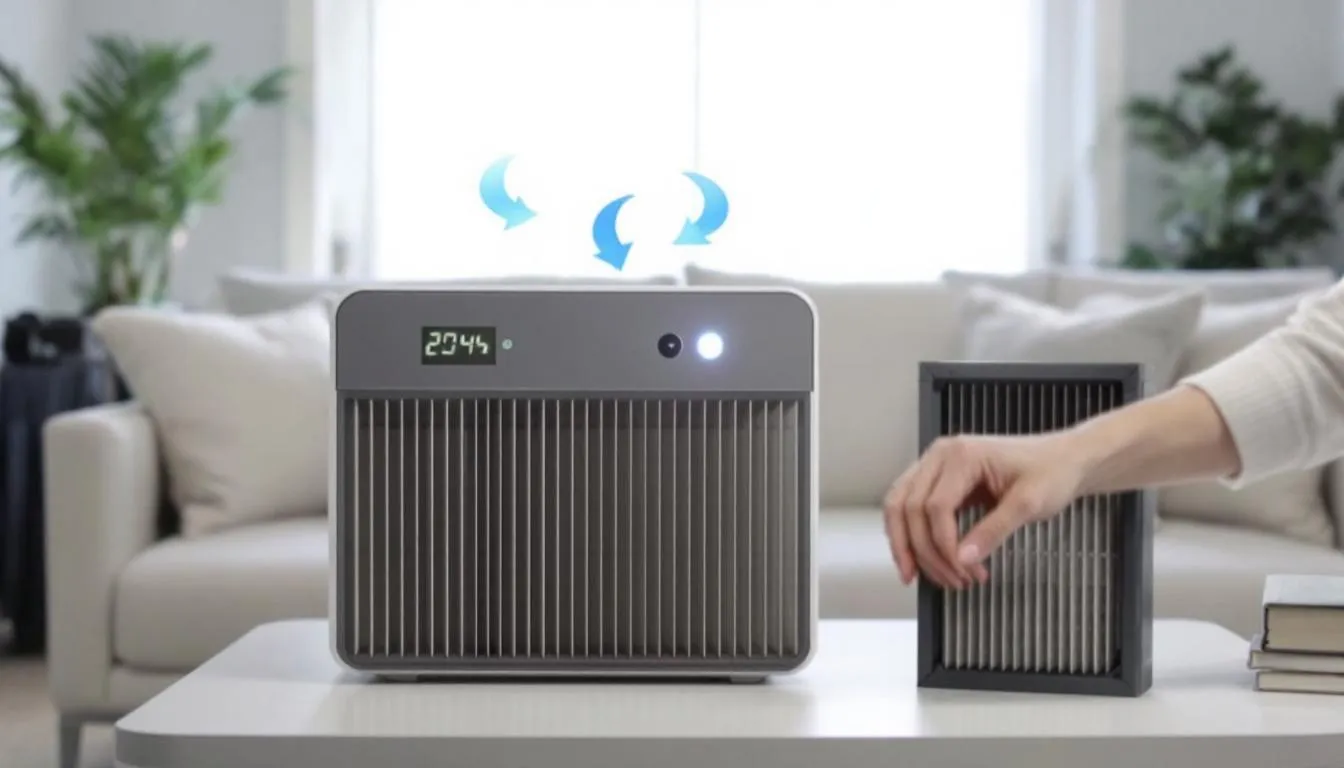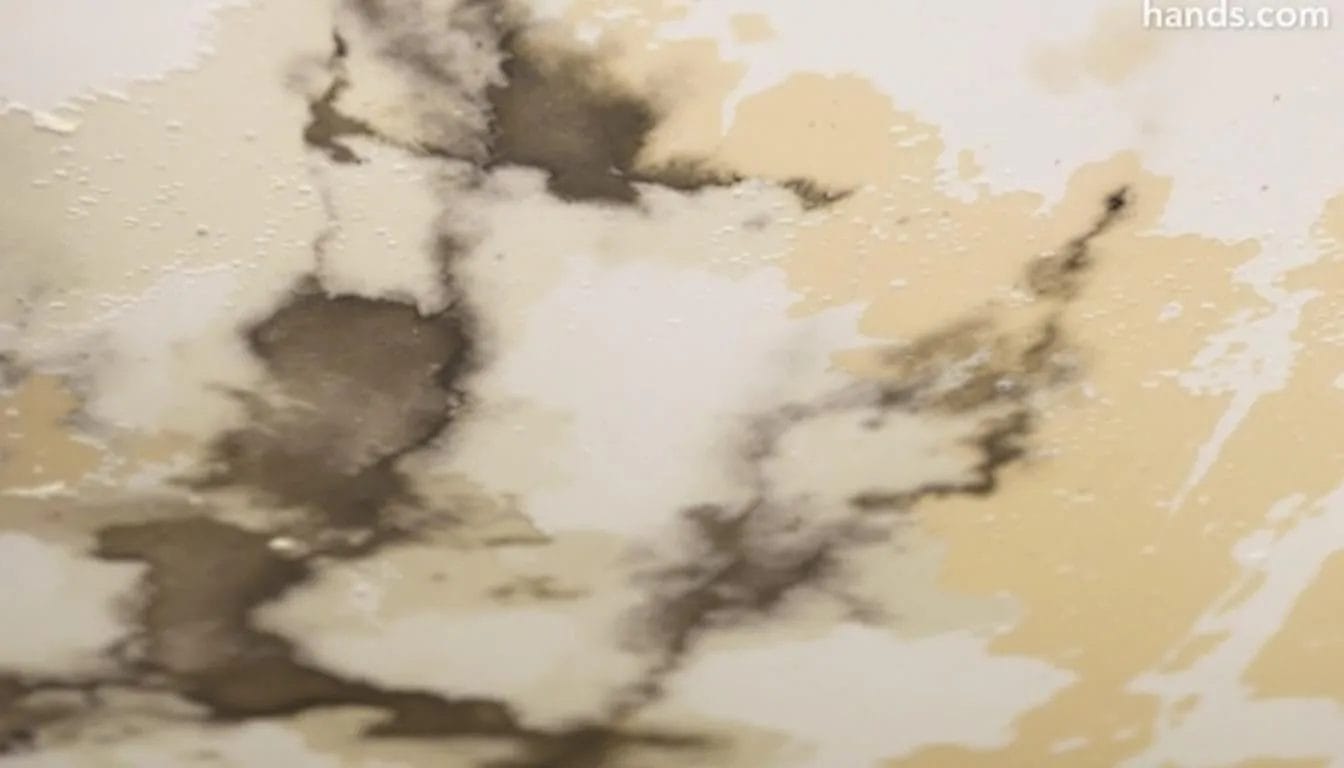Need to clean smoke damage on walls and ceiling? This guide will show you how to clean smoke damage on walls and ceiling by identifying, cleaning, and restoring your space effectively.
Key Takeaways
- Identifying smoke damage early, such as soot residue and smoke odor, is crucial for effective restoration and prevents further complications.
- Proper preparation and protective measures, including ventilation and covering furniture, are essential steps before cleaning smoke damage.
- Persistent smoke odors and stubborn stains may require specialized cleaning solutions or professional intervention for thorough removal and restoration.
Table of Contents
Identifying Smoke Damage on Walls and Ceilings

Prompt recognition of smoke damage helps prevent further issues and supports effective restoration. Common signs of smoke damage on walls and ceilings include blackened areas, soot streaks, and discoloration. These indicators are often accompanied by a persistent smoke odor that can permeate the entire room. Early identification of smoke damage can save you time and effort in the long run by allowing you to address the issue before it worsens.
Smoke damage can manifest in various forms, including:
- Visible soot particles
- Stains
- Warped paint
- Structural damage
Thoroughly inspect your walls and ceilings for smoke damage, particularly after a house fire or prolonged cigarette smoke exposure. Early identification allows for timely cleaning and restoration of your home.
Soot Residue
Soot residue is one of the most common indicators of smoke damage and smoke and soot damage. This greasy black substance is caused by incomplete combustion and can lead to streaks or yellowish discoloration on light-colored surfaces. Soot particles tend to adhere to cooler surfaces, such as walls and ceilings, making them a prime target for more soot buildup in an inconspicuous area. Soot damage can be particularly challenging to address if not treated promptly, especially when dealing with soot stains.
The presence of soot residue not only affects the appearance of your home but can also pose health risks if not properly cleaned.
Smoke Odor
A persistent smoke odor is a telltale sign of hidden smoke damage, even if there are no visible marks on the walls and ceilings. Smoke can penetrate surfaces, causing odors that are difficult to locate and remove. This odor can be particularly stubborn, as walls and other materials absorb the smoke smell and release it back into the room over time.
Identifying and addressing smoke odor is crucial for a thorough smoke damage restoration process.
Physical Damage
Physical damage from smoke can include discoloration, structural issues, and soot buildup, which may require the replacement of affected materials. Walls and ceilings exposed to smoke often suffer from staining and potential long-term damage. Moreover, moisture from firefighting efforts can exacerbate the situation by promoting mold growth and compromising the integrity of materials. Assessing the physical damage is essential to determine the extent of the restoration needed.
In addition to visible damage, smoke can penetrate deeper into wall materials, affecting insulation and other hidden components. It’s important to evaluate the integrity of drywall and other materials after smoke exposure, as the corrosive nature of smoke compounds can weaken structural elements. In cases of extensive smoke exposure, professional assessment may be necessary to ensure the safety and stability of your home.
Preparing for Cleaning Smoke Damage
Before diving into the cleaning process, it’s crucial to prepare the affected area to ensure a thorough and efficient cleanup. Start by:
- Ensuring the area is free from lingering smoke and debris, as this will facilitate a more effective cleaning process.
- Surveying the area to determine the next steps.
- Vacuuming any loose soot from surfaces.
Proper preparation can make a significant difference in the outcome of your cleaning efforts.
Ventilation is key when dealing with smoke damage. Open windows and use fans to increase airflow, helping to reduce smoke odors and improve air quality. Additionally, regular cleaning of air filters and HVAC systems can help maintain air quality and reduce smoke particles.
Wear protective clothing and cover floors and furniture to avoid additional damage during cleaning.
Proper Ventilation
Ventilating the area prevents the buildup of harmful smoke particles indoors. Open windows and doors near the affected area to facilitate airflow, and continue to do so throughout the cleaning process.
Using fans can also help maintain fresh air circulation, which is crucial for both health and cleaning efficiency.
Protective Clothing
Protective clothing is necessary to guard against harmful soot and cleaning chemicals. To minimize contact with hazardous materials, the following should be worn:
- Long sleeves
- A mask
- Safety gloves
- Safety goggles
Rubber gloves and safety goggles protect your skin and eyes during soot removal. It is advisable to wear gloves.
Protect Floors and Furniture
Cover floors and furniture to protect them from soot and cleaning chemicals during smoke damage cleanup. Cover furniture and floors with protective materials, such as plastic sheeting or drop cloths, to shield them from damage.
This precaution will help ensure that your cleaning efforts are focused on the clean walls, smoke-damaged walls and ceilings without causing additional issues.
Tools and Materials Needed
The right tools and materials are crucial for effective smoke damage cleaning. Ensure you have:
- Rubber gloves, goggles, and rags to protect against soot and cleaning chemicals
- A ladder or sturdy step stool for reaching high areas, such as ceilings
- A mild soap or detergent mixed with tri-sodium phosphate for cleaning surfaces affected by smoke
Consider the areas that need cleaning, such as:
- Carpets
- Flooring
- Furniture Gather the necessary cleaning materials accordingly. The proper tools and materials enhance cleaning efficiency and effectiveness, aiding in restoring your home to its pre-damage state.
Dry Cleaning Sponge
A dry cleaning sponge effectively absorbs soot without spreading it. This type of sponge is particularly effective for removing soot from surfaces, reducing the amount of soot spread during the cleaning process. Additionally, a dry chemical sponge can be used for similar applications.
Dry cleaning sponges significantly enhance cleaning efficiency and restore the appearance of walls and ceilings.
Cleaning Solution
A suitable cleaning solution is necessary for effective smoke damage cleanup:
- Use a mild soap or detergent mixed with warm water as an excellent choice for cleaning surfaces affected by smoke.
- Mix detergent with warm water to create bubbles that lift grime and soot.
- Apply this cleaning solution on surfaces that have been treated to remove loose soot first.
Apply the cleaning solution gently with a soft cloth or sponge, working in small sections to control clean soot spread. This method ensures that the soot is lifted without causing further damage to the surfaces and helps to remove soot effectively.
Rinse the clean cloth regularly in hot water or switch to a new one to maintain cleaning effectiveness.
Vacuum Cleaner with HEPA Filter
A HEPA-filter vacuum cleaner is essential for smoke damage cleanup. HEPA filters are designed to capture small soot particles effectively, making them ideal for removing soot from surfaces.
A HEPA-filter vacuum ensures thorough removal of soot particles, preventing further spread and damage.
Step-by-Step Guide to Clean Smoke Damage
A systematic approach is necessary for thorough smoke damage restoration. The first step is to remove loose soot using a dry cleaning sponge by wiping in a vertical downward motion. This technique lifts soot without spreading it. Use specific techniques and regular tools for heavy soot residue.
Next, use a gentle cleaner like dish soap mixed with warm water and soapy water to wash the affected areas with a spray bottle. Clean in small sections to control soot spread and ensure thorough rinsing.
Rinse with clean water and dry with a soft cloth to avoid water damage. This guide helps in effectively cleaning and restoring smoke-damaged walls and ceilings.
Removing Loose Soot
Start by removing loose soot from the ceilings to prepare for wall cleaning. Follow these steps:
- Use a dry cleaning sponge to gently wipe the surfaces and remove most of the smoke.
- Avoid oversaturating the surfaces to prevent damage.
- Consider vacuuming the soot first to prevent it from spreading into the walls.
Washing with Cleaning Solution
When washing with a cleaning solution, follow these steps:
- Work in small sections to avoid spreading soot and ensure thorough cleaning.
- Use a soft cloth or sponge to apply the cleaning solution gently on the affected areas.
- Regularly rinse the cloth or switch to a new one to maintain the effectiveness of the cleaning process.
Proper washing techniques prevent soot spread and further damage to walls and ceilings. Use a gentle circular motion when applying the cleaning solution, and be careful not to oversaturate the surfaces. This method will help you clean smoke damage effectively and restore the appearance of your home.
Rinsing and Drying
After washing, follow these steps to dry the cleaned areas:
- Rinse the cleaned areas with clean water.
- Dry with a soft cloth.
- Use a towel to absorb any excess moisture to help prevent water damage.
- Allow the walls and ceilings to air dry in a well-ventilated room to ensure thorough drying and prevent mold growth.
Proper ventilation and quick drying are essential to avoid further damage.
Quickly drying walls prevents water damage and ensures successful restoration. Use fans and open windows to increase airflow and speed up the drying process. This step will help you achieve a thorough and effective cleanup of smoke damage.
Dealing with Stubborn Smoke Stains
Basic cleaning methods may sometimes be insufficient for removing stubborn smoke stains. These persistent stains require more intensive cleaning techniques to restore your walls and ceilings to their original condition. Creating a mixture of baking soda and water can be an effective solution for scrubbing away these tough stains.
Addressing stubborn smoke stains may involve:
- Multiple steps and repeated cleaning
- Using the correct cleaning materials and techniques to prevent further surface damage
- Additional methods like white vinegar solutions
- Repainting to eliminate stains completely
Baking Soda Paste
Mix baking soda with water to achieve a thick consistency for a paste. Remove initial soot with a dry cleaning sponge and prepare a solution with mild detergent and warm water.
Scrub stubborn stains with the baking soda paste using a soft cloth or sponge, working in small sections. Rinse scrubbed areas with cold water and a damp cloth, then dry thoroughly to prevent mold.
White Vinegar Solution
Combine equal parts white vinegar and warm water to prepare a cleaning solution. Use a soft cloth or sponge to apply the solution in small sections, lifting difficult smoke stains.
White vinegar helps remove stains and neutralize smoke odors, making it a versatile cleaner.
Repainting
Repainting may be necessary after thoroughly cleaning smoke-damaged surfaces to restore their appearance. Apply a durable primer to block stains and ensure proper paint adhesion. If stains are still visible after the first coat of primer, apply a second coat to cover the entire wall.
Use self-priming paint with good coverage to effectively conceal smoke damage and achieve a smooth finish. Wait around two hours before applying a second coat of primer to ensure proper drying.
Repainting is crucial for restoring your home’s aesthetics and protecting surfaces from future damage.
Addressing Smoke Odor

Smoke odor can persist long after visible damage is cleaned, making thorough odor removal essential. Methods to remove smoke odors include:
- Using tri-sodium phosphate (TSP), which effectively removes smoke odors from various surfaces.
- Applying white vinegar, whose acidity breaks down smoke residues and neutralizes lingering odors.
- Seeking professional help if standard cleaning methods cannot remove persistent smoke odors.
Residual smoke can cause health problems, making complete elimination of smoke odors crucial. Techniques such as ozone generators, thermal fogging, and air purifiers can help remove smoke odors and improve air quality in your home.
Eliminating smoke odor is critical for a healthy and pleasant living environment after smoke damage.
Ozone Generators
Ozone generators alter the chemical composition of smoke molecules, effectively neutralizing odors. An ozone generator can be left unattended as it spreads ozone and breaks down smoke molecules.
Typically, ozone treatment for smoke odor can be completed within a day, making it a convenient and efficient solution for persistent smoke odors.
Thermal Fogging
Thermal fogging involves:
- Heating a deodorizer and spraying it in fog form to effectively penetrate surfaces.
- Distributing deodorizing agents throughout smoke-damaged areas.
- Ensuring comprehensive odor removal.
Thermal fogging effectively eliminates smoke odors and improves air quality.
Air Purifiers
HEPA-filter air purifiers are essential for removing smoke particles from the air. HEPA filters trap 99.97% of particles 0.3 microns in size, including smoke particles.
Air purifiers continuously remove airborne smoke particles, enhancing overall air quality and eliminating smoke odors for a healthier environment.
When to Call Professionals
DIY methods can handle minor smoke damage, but professional intervention may be necessary for more severe cases. Charred walls or warped floors indicate the need for professional restoration. Health issues like respiratory problems from smoke exposure necessitate expert restoration services. Attempting to clean extensive smoke damage yourself risks incomplete soot removal and further property damage.
Professional restoration services ensure thorough cleaning and restoration of severe smoke damage with their expertise and equipment. Seek professional help for health issues related to smoke exposure or extensive damage to address the problem effectively.
Professionals assist with insurance claims by providing necessary assessments and documentation.
Extensive Damage
Contact professionals for smoke damage restoration if the damage is widespread or structural. Signs like warped or blistered paint may indicate the need for professional restoration due to fire heat exposure.
Professional assessments support insurance claims and ensure thorough, safe damage restoration.
Health Concerns
Smoke exposure can cause health issues such as respiratory problems and irritations. Open windows and doors during cleaning to allow fresh air circulation and reduce harmful pollutants.
Seek expert assistance if you experience persistent health issues related to smoke exposure.
Insurance Claims
To handle smoke damage restoration, follow these steps:
- Contact your insurance company before cleaning to report smoke damage and start the claims process.
- Ensure thorough documentation and professional assessments to support your claim.
- This will help ensure necessary coverage for smoke damage restoration.
Preventing Future Smoke Damage

Implement proactive measures to reduce the risk of smoke and fire incidents to prevent future smoke damage:
- Install smoke detectors.
- Use fire-resistant materials to minimize the risk of smoke damage.
- Perform regular maintenance.
- Ensure proper ventilation to help prevent smoke residue buildup over time.
High-quality candles made from natural waxes burned in well-ventilated spaces reduce soot and smoke emissions. Using dehumidifiers controls moisture levels, reducing the risk of smoke damage.
These preventive measures protect your home from future smoke damage, maintaining a clean and healthy environment.
Avoid Indoor Smoking
Encourage outdoor smoking to maintain a clean indoor environment and prevent smoke buildup. Indoor smoking causes nicotine stains on walls and ceilings, contributing to smoke damage.
Smoking only outdoors prevents these issues and keeps your home smoke-free.
Use High-Quality Candles
High-quality candles burn efficiently, producing less soot and reducing smoke damage on walls and ceilings. Opting for candles made from natural waxes instead of paraffin can help reduce candle smoke emissions when burned.
Following the manufacturer’s instructions regarding burn time can also help minimize soot production and prevent damage.
Regular Maintenance
Routine cleaning of surfaces helps prevent the buildup of smoke residues over time. Establish a cleaning schedule that includes regular dusting and washing of surfaces exposed to smoke.
Adopting regular maintenance practices will contribute to better air quality in your home and reduce health risks associated with smoke exposure.
Summary
Cleaning smoke damage from your walls and ceilings is a multifaceted process that requires careful planning and execution. By identifying smoke damage early, preparing adequately, and using the right tools and materials, you can effectively restore your home. Techniques such as using dry cleaning sponges, appropriate cleaning solutions, and HEPA filter vacuums are crucial for removing soot and smoke residues. Additionally, addressing stubborn smoke stains and odors ensures a thorough cleanup.
Preventive measures, such as avoiding indoor smoking and using high-quality candles, can help reduce the risk of future smoke damage. Regular maintenance and proper ventilation are also essential for maintaining a smoke-free environment. By following the steps outlined in this guide, you can restore your home to its original condition and protect it from future smoke damage. Remember, when in doubt, seek professional help to ensure a safe and effective restoration process.
Frequently Asked Questions
How can I identify smoke damage on my walls and ceilings?
To identify smoke damage on your walls and ceilings, look for blackened areas, soot streaks, discoloration, and lingering smoke odors. These signs indicate the presence of smoke damage that needs attention.
What tools and materials do I need to clean smoke damage?
To effectively clean smoke damage, gather rubber gloves, goggles, rags, a dry cleaning sponge, a suitable cleaning solution, and a vacuum cleaner with a HEPA filter. These tools will help ensure a thorough and safe cleaning process.
How do I remove stubborn smoke stains?
To effectively remove stubborn smoke stains, create a paste using baking soda or use a white vinegar solution for scrubbing. After cleaning, consider repainting if the stains persist.
When should I call professionals for smoke damage restoration?
You should call professionals for smoke damage restoration when there is extensive damage, visible structural issues, or health concerns from smoke exposure. Their expertise is crucial for effective restoration and navigating insurance claims.
How can I prevent future smoke damage in my home?
To prevent future smoke damage in your home, avoid indoor smoking, use high-quality candles, and ensure proper ventilation. Regular maintenance and the installation of smoke detectors are also essential.


